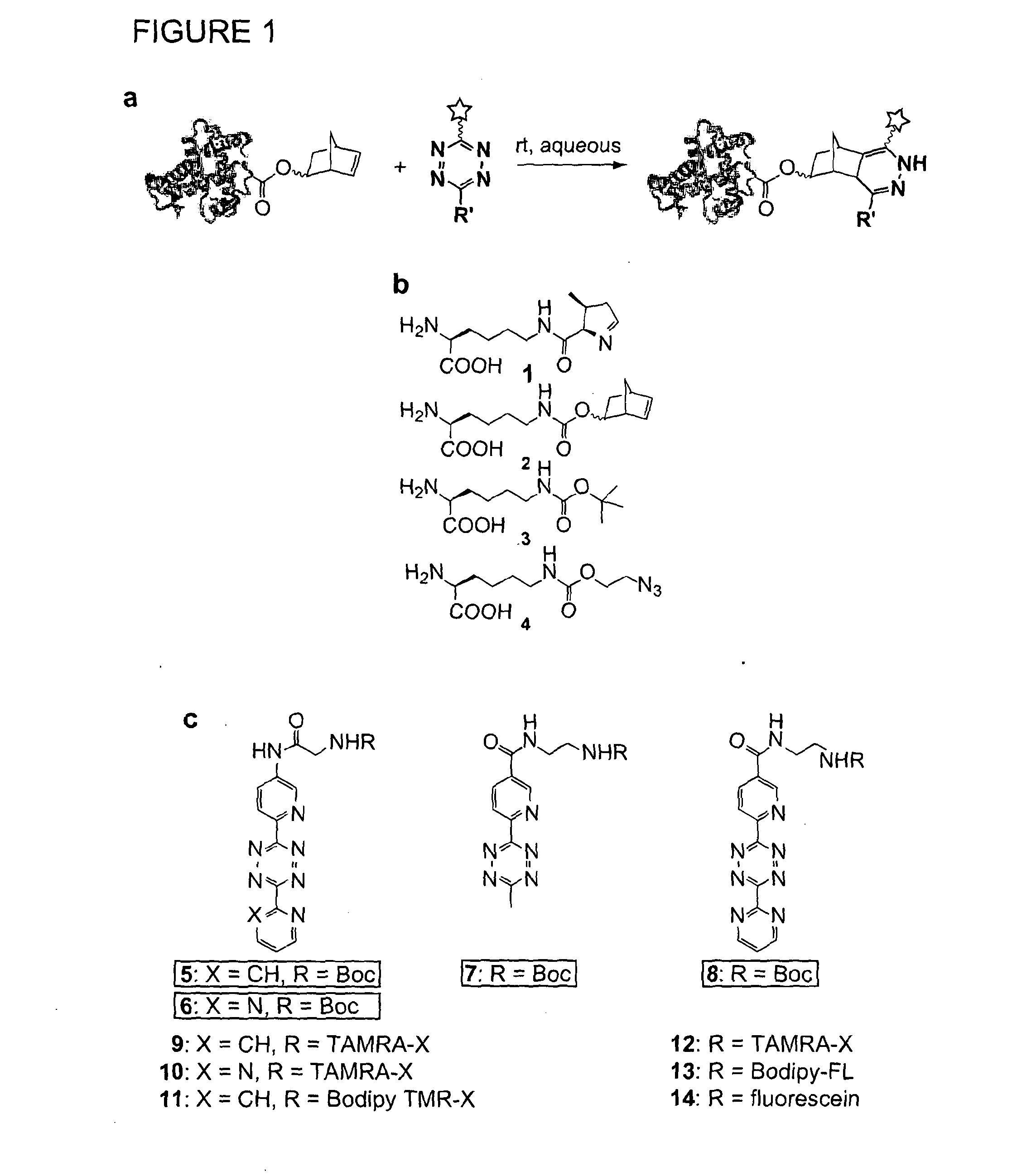Norbornene Modified Peptides and Their Labelling With Tetrazine Compounds
a technology of modified peptides and tetrazine compounds, which is applied in the field of tetrazine compound labeling of tetrazine compounds, can solve the problems of limited set of probe molecules, main limitation of fluorescent protein fusion, and general insufficient residue-specific method of protein modification, so as to achieve better yields and protein expression. the effect of yield
- Summary
- Abstract
- Description
- Claims
- Application Information
AI Technical Summary
Benefits of technology
Problems solved by technology
Method used
Image
Examples
example 1
REFERENCES TO EXAMPLE 1
[0140]1. Basle, E., Joubert, N. & Pucheault, M. Protein chemical modification on endogenous amino acids. Chem Biol 17, 213-227 (2010).[0141]2. Sletten, E. M. & Bertozzi, C. R. Bioorthogonal chemistry: fishing for selectivity in a sea of functionality. Angew Chem Int Ed Engl 48, 6974-6998 (2009).[0142]3. Tsien, R. Y. The green fluorescent protein. Annu Rev Biochem 67, 509-544 (1998).[0143]4. Lippincott-Schwartz, J. & Patterson, G. H. Development and use of fluorescent protein markers in living cells. Science 300, 87-91 (2003).[0144]5. Hadjantonakis, A. K., Dickinson, M. E., Fraser, S. E. & Papaioannou, V. E. Technicolour transgenics: imaging tools for functional genomics in the mouse. Nat Rev Genet 4, 613-625 (2003).[0145]6. Strack, R. L. et al. A noncytotoxic DsRed variant for whole-cell labeling. Nat Methods 5, 955-957 (2008).[0146]7. Tour, O. et al. Calcium Green FlAsH as a genetically targeted small-molecule calcium indicator. Nat Chem Biol 3, 423-431 (2007...
example 1a
Targeting Varied Residues
[0181]The target residue need not be a lysine in the polypeptide of interest. The following proteins have been expressed with norbornene lysine (NorK) incorporated at (i.e. substituted into) the following positions:
T4 lysozyme (position 83, in wildtype position 83 is a lysine)
Myoglobin (position 4, which in the wildtype sequence is a serine)
sfGFP (position 150, which in the wildtype is an asparagine)
[0182]Thus targeting of residues other than lysine is demonstrated.
example 1b
Selectivity of the norbornene-tetrazine reaction against the E. coli proteome
[0183]To probe the specificity of the reaction between the genetically encoded norbornene and the tetrazine-based fluorophores we performed the labelling reaction in the proteome of E. coli expressing either c-terminally His-tagged sfGFP or His-tagged myoglobin. We controlled the level of recombinant protein expression so that it was equal to or less than that of many endogenous proteins by modulating the concentration of norbornene-lysine added to cells. This ensures that any specific labelling of the target protein versus native proteins is not an artefact of the abundance of the target protein.
[0184]Cells were harvested 3 to 4 hours after induction of protein expression, washed with PBS and incubated with fluorophore probes at room temperature. After washing the cell pellets, the cells were lysed and the reaction mixtures were analyzed by SDS PAGE to assess proteome levels. Fluorescence scanning of SDS-...
PUM
 Login to View More
Login to View More Abstract
Description
Claims
Application Information
 Login to View More
Login to View More - R&D
- Intellectual Property
- Life Sciences
- Materials
- Tech Scout
- Unparalleled Data Quality
- Higher Quality Content
- 60% Fewer Hallucinations
Browse by: Latest US Patents, China's latest patents, Technical Efficacy Thesaurus, Application Domain, Technology Topic, Popular Technical Reports.
© 2025 PatSnap. All rights reserved.Legal|Privacy policy|Modern Slavery Act Transparency Statement|Sitemap|About US| Contact US: help@patsnap.com



